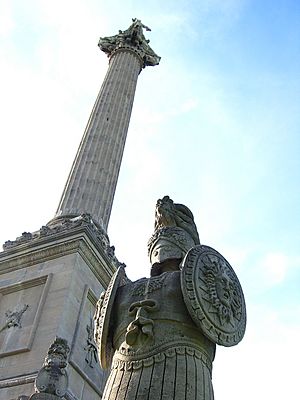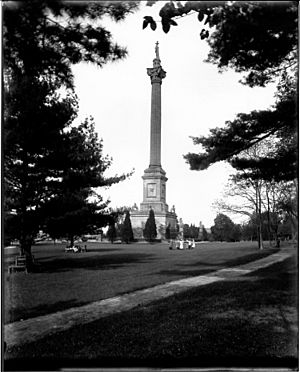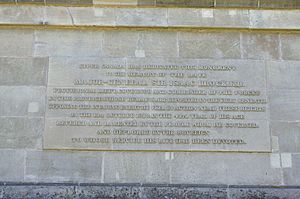Brock's Monument facts for kids
 |
|
| Coordinates | 43°09′36.5″N 79°03′11.0″W / 43.160139°N 79.053056°W |
|---|---|
| Location | Queenston Heights, Queenston, Ontario |
| Designer | William Thomas |
| Material | limestone |
| Height | 56 m (184 ft) |
| Beginning date | 1853 |
| Completion date | 1856 |
| Opening date | 1859 |
| Dedicated to | Sir Isaac Brock |
Brock's Monument is a tall, impressive column that stands 56 meters (about 185 feet) high. You can find it on Queenston Heights in Queenston, Ontario, Canada. This monument honors Major General Sir Isaac Brock, a brave hero from the War of 1812.
Sir Isaac Brock was a British Army officer. He was in charge of defending Upper Canada (which is now part of Ontario) from an invasion by the United States. He and one of his helpers, Lieutenant-Colonel John Macdonell, are buried at the base of this monument. They rest on the heights above the battlefield where they both died during the Battle of Queenston Heights.
The monument you see today was built between 1853 and 1856. It replaced an earlier monument that stood from 1824 to 1840. Parks Canada takes care of Brock's Monument. It is a very important part of the Queenston Heights National Historic Site. This monument is also the fourth oldest war memorial in Canada.
Contents
The Story of Brock's Monument
Sir Isaac Brock was shot and killed on the morning of October 13, 1812. He was leading British soldiers and Canadian volunteers up the Heights. They were trying to take back a fort that American soldiers had captured. One of Brock's assistants, John Macdonell, was also seriously injured and later died during the battle.
Even though they lost their leader, the combined forces of British, Canadian, and First Nations soldiers won a big victory that day. This win was led by Major-General Roger Hale Sheaffe.
Brock and Macdonell were first buried at Fort George, Ontario nearby. People in Upper Canada soon wanted to honor Brock. His dramatic death made him a symbol of Canadian independence. This led to the building of the first Brock's Monument. It was a 41-meter (135-foot) column with a viewing platform. Construction started in 1823, and it opened on October 13, 1824.
During its building, a newspaper editor named William Lyon Mackenzie wanted to put a special message inside the monument. The government leader, Peregrine Maitland, said no. He didn't want a newspaper that criticized the government to be included.
A Monument Damaged
On April 17, 1840, someone used explosives to damage the first monument. It was badly hurt but did not fall down. People believed a person named Benjamin Lett, who was against the British government, was responsible. After the damage, Brock and Macdonell's remains were moved to a different burial ground.
A New Monument Rises
Soon after, people started a campaign to rebuild the monument. In 1852, Toronto architect William Thomas created a design for an even grander monument. A skilled stone carver, Charles Thomas Thomas, oversaw the building.
Construction began in 1853, using limestone from a nearby quarry. It took three years to finish. Brock and Macdonell's remains were brought back to Queenston Heights and buried there for the fourth time. The new monument officially opened on October 13, 1859. A smaller stone marker, closer to where Brock died, was dedicated by Prince Edward (who later became King Edward VII) in 1860.
A special message was placed on Brock's coffin when he was reburied. It honored him as a "brave and virtuous hero" who died fighting for his country.
In 1929, a lightning strike hit the monument. It severely damaged Brock's statue, causing large pieces to fall off.
In 2003 and 2004, engineers checked the monument. They found that it needed a lot of repair work inside and out. Parks Canada closed the monument to visitors in 2005 for these repairs. A big restoration project started in 2008 and finished in May 2009. The work included fixing the inside walls to stop moisture and adding emergency lights.
What You'll See at the Monument
The main entrance to the monument has two large mulberry trees. People believe these trees were planted in the 1850s.
Inside the Monument's Base
Inside the base of the monument, you'll find several brass plaques. These plaques tell the stories of Brock and Macdonell. They also list the people who donated money and helped build the monument. There is also a tribute to the British, Canadian, and First Nations soldiers who died in the Battle of Queenston Heights. Brock and Macdonell's bodies are buried in special crypts within the limestone walls.
Newer displays explain Brock's life, the battle, and the monument's history. You can even see a piece of Brock's statue arm that fell off in 1929.
Climbing to the Top
A spiral staircase with 235 steps goes up inside the column. Visitors can climb these steps to reach a small indoor platform. This platform is just below Brock's statue. From the Porthole windows, you can see amazing views of the Niagara region and Lake Ontario.
Other Sights Nearby
At night, the monument is lit up, making it a beautiful sight. It marks the end of a historical walking trail. This trail goes through Queenston Heights and tells about important events from the battle.
There is also a small monument to Tecumseh nearby. It is about 3 feet tall and made of twigs and feathers. This special tribute is cared for by local people, not by Parks Canada.
See also
- Monarchy in Ontario
- Canadian war memorials






